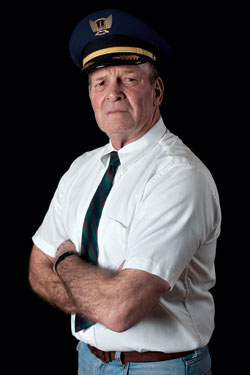
Name: Al Slader, co-pilot
Flight: United Flight 811, Honolulu to Auckland, New Zealand
Date: February 24, 1989
Incident: Explosive decompression owing to cargo-door failure
Fatalities: 9
Survivors: 346
We were about 72 miles from Honolulu, approaching 23,000 feet, when the cockpit door blew open. It felt like a bomb.
Mark Thomas, our flight engineer, went down the spiral staircase to see what was going on in the cabin. From where he stood, he could see no airplane—just sky and clouds and water. He came back and said, “The whole side of the airplane’s gone, and we’ve got people outside.” He meant that they’d died. He’d tried to talk to flight attendants but couldn’t because the noise was so bad. We found out later they didn’t even know if any of us in the cockpit were alive.
In a situation like that, the first thing you try and do is just keep the airplane in the air. We had two engines out, which meant we were a good 150,000 pounds heavier than the two remaining engines could sustain. We had about 220,000 pounds of fuel, which we could dump, but a Boeing 747 only dumps 5,000 pounds a minute, which wasn’t fast enough. So there was no doubt we were going to go down. It was just a matter of where.
In a decompression, the first thing pilots are supposed to do is put on the oxygen masks. Well, guess where the oxygen bottles were stored? Right next to the door. So when we put the masks on, there was no oxygen. We threw them on the floor.
After we established communication in the cockpit, the next step was to descend to breathable air, which the FAA considers to be 10,000 feet. As the pilot, Dave Cronin, started the descent, Mark Thomas and I were trying to figure out what systems we had left. I shut the two engines off at the fuel switch, which put the fire out that was shooting out of No. 4. According to United’s procedure for severe engine damage, the next step would have been to pull what’s called the firewall shutoff. But that would have meant losing two hydraulic systems and half of our flight control. We would have ended up in the water, for sure. So I abandoned protocol.
Dave did, too. He was supposed to get us to 10,000 feet as fast as possible, but with the second engine shut down he realized what we needed most of all was altitude. Nobody was going to die breathing at 20,000 feet, and we’d never make it to the airport if we continued our descent.
We had reversed course back to Honolulu, and we were just trying to get as close to the airport as we could. The explosion occurred over water 17,000 feet deep. We hoped we could at least get to the beach or the shallow water, where if we had to put the airplane in the water, Coast Guard might be able to help. By the time we got to 8,000 feet, I called Honolulu and said, “We may not be able to make it.”
But we were dumping fuel the whole way, which was making us lighter and helping us do a little better. Finally I said, “My God, we’re gonna make it!” Landing wasn’t going to be easy, though. We didn’t know how much damage the airplane had sustained. Did we still have brakes? Would the landing gear come down? Would the flaps come down evenly, or would the airplane roll over on its back?
At about 4,000 feet we went through a layer of clouds and the airport came into view. The tower cleared us to land on the longest runway available. We started to try to get the flaps out, but sure enough, we ended up with an asymmetric flap condition. Dave turned to Mark Thomas, the flight engineer, and asked for our approach. But all of Mark’s flight procedures and tables for landing weights had blown out of the cockpit. “I have no idea,” Mark said. “I don’t have any books or manuals or any of the stuff I need to do that.”
“Well, what do you think we should use?”
“Two hundred knots,” Mark said. He just pulled it out of the air. “Yeah, that’s a good one. Let’s use 200 knots.”
So that’s what we did. A half-mile out, Mark yelled through the PA: “Brace! Brace! Brace!” Dave held the landing gear until the last minute because we didn’t need drag, we needed power. We landed, and immediately the fire department started putting out fires. We’d been in the air for 22 minutes since the explosion.
I was the last one out of the plane. I walked through the cabin with my flashlight to make sure everybody was out. All the suction toward the front of the plane had torn out the projectors, the overhead bins, even the toilets. The first five rows of seats were gone.
A lot of pilots say, “God, I’m glad that was you and not me.” But you know what? We train and practice all sorts of emergency procedures our entire career. To take the final test, the big test, and pass it—I wouldn’t trade that. I think a lot of guys who fly airplanes would love to take the big test and find out if they could pass it.
I was at a restaurant in Denver a while back, and one of the guys from the flight, a lawyer, was having dinner with a friend. I hear this guy yell, “Slader! Slader!” And he jumps up and he’s walking through the restaurant, yelling, “This guy saved my life!” And he turns to the waiter and says, “Whatever he wants, give it to him and send the check to me.” I was embarrassed, but, yeah, sure, it made me happy.
As told to Jacob Gershman.